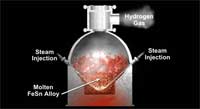Diversified Energy Corporation (DEC) and Velocys Inc. have been selected by the U.S. Department of Defense (DoD) to design a portable renewable fuel production system based on DEC’s breakthrough HydroMax gasification technology and Velocys’ advanced Fischer-Tropsch approach.
The goal of the DoD funded effort is to develop a transportable system that can convert waste products generated at military installations into 50 – 500 barrels per day of high performance renewable fuels such as diesel and aviation fuel. The technologies are the same as those used for the production of synthetic biofuels (biomass-to-liquids) that can be made from any type of cellulosic biomass.
The development of portable, small-scale biomass-to-liquids (BtL) plants that yield ultra-clean synthetic biofuels would be a major breakthrough that could unlock the large potential of cellulosic biomass. It would considerably improve the logistics of next-generation biofuels by allowing producers to decentralise production. Decentralisation consists of placing facilities near abundant biomass sources, instead of transporting bulky feedstocks to a central facility.
DoD is the single largest fuel consumer in the United States, with an annual fuel budget of approximately $9 Billion and rising. Forward operating military bases generate scores of waste material and have an enormous demand for fuel products. As a result, an opportunity exists to incorporate advanced energy conversion technologies that can utilize waste materials to generate high performance fuels; thereby, reducing the logistical burden of fuel transportation for military operations. These benefits will ultimately result in lower military operating costs and markedly improved energy security for the DoD.
DEC’s HydroMax gasification technology, under license from Alchemix Corporation, will be used to convert waste products (biomass, solid-waste, etc.) into a synthetic gas (syngas). The Velocys fuel synthesis technology will then convert the syngas from HydroMax into diesel and jet fuel that can be utilized for a wide variety of military applications. This DOD Small Business Innovative Research (SBIR) Phase I project will include bench-scale test data analysis, conceptual design of a transportable fuel production system, economic analysis, and a detailed assessment of system modularity and transportability.
Utilizing an iron/tin molten metal based reactor, the HydroMax system produces both carbon monoxide (CO) and hydrogen (H2) in separate and distinct streams from the reactor. These streams can be used to create electricity in turbines, produce transportation fuels or chemicals through various synthesis processes, or deliver high-quality hydrogen for a multitude of applications.HydroMax differs substantially from traditional gasification technologies, whose basic approach is to create synthetic gas by partially combusting coal in an oxygen-starved environment - a technique which has seen little change since its inception in the late 18th century. By leveraging proven processes from the metals and mining industries, the HydroMax technique intends to break the status-quo paradigm by delivering gasification systems at up to 50% the cost of traditional systems, with 80+% efficiency, and demonstrating high availability.
Using two distinct steps, the HydroMax process begins with a molten iron/tin (FeSn) bath heated to 1300° C. In Step A, steam is injected into the bath which is then thermo-chemically split resulting in H2 gas (released) and oxidized iron. After the Fe is oxidized, steam injection ceases and a carbon source (coal, petroleum coke, tires, biomass, etc) is injected into the reactor. Carbon has a high affinity to oxygen and reduces the oxidation of Fe to its pure form and produces a CO-rich syngas which is released for use.
Diversified Energy and its partners are working to execute on a research and development plan to validate the operational and economic benefits of the system. The company is spending its own resources and engaging with the government to conduct a series of hardware tests aimed at commercializing HydroMax as quickly as possible.
Working with Diversified Energy on this critical DoD fuel project is ideal for Velocys as our technology integrates nicely with DEC’s HydroMax gasification approach. Our gas-to-liquids technology is one-tenth that of conventional systems and, as a result, we are able to achieve the transportability objective outlined by the DoD. - Jeff McDaniel, Velocys Business Development Manager
At the conclusion of the Phase I SBIR effort, the Diversified Energy/Velocys team will compete for a Phase II project that will fund development of a prototype integrated fuel production system.

